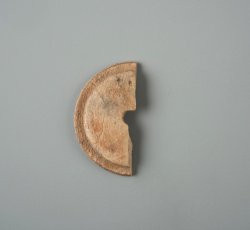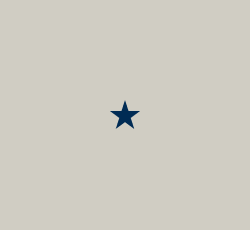2 Piece - Page 1 of 2

Two-piece round button with iron back.
Copper/Copper Alloy | Object #: 1694094
Possible waistcoat or large utilitarian button.
Explore This Item
Copper alloy button with iron back.
Copper/Copper Alloy | Object #: 1694205
Button face appears to be crimped onto iron back; single hole in the center of the button with iron bar running across.
Explore This Item
Modern button.
Synthetic/Modern | Object #: 1694209
Interior ring of possible painted or coated copper alloy inset into exterior circular plastic ring.
Explore This Item
Silver-alloy plated copper alloy button face with stamped floral and geometric design.
Copper/Copper Alloy | Object #: 1785147
This is the metal face, or front portion, of a two piece button. In this style of button, a disk of lathed bone with a beveled edge often served as a button back. The face of the button was commonly fashioned from a sheet of thin metal, usually a variety of copper alloy, which would be crimped ...
Explore This Item
Bone back to waist coat button with wire eye.
Bone | Object #: 1787213
Bone button molds were disks cut from animal bone, often identifiable by the presence of a single central hole created by a cutting tool during production. The bone disk often served as the back of a two part button. In this button form, the face of the button was commonly comprised of a stampe...
Explore This Item
Bone back to waist coat button with wire eye.
Bone | Object #: 1787433
Bone button molds were disks cut from animal bone, often identifiable by the presence of a single central hole created by a cutting tool during production. The bone disk often served as the back of a two part button. In this button form, the face of the button was commonly comprised of a stampe...
Explore This Item
Bone back to coat button with wire eye.
Bone | Object #: 1787434
Bone button molds were disks cut from animal bone, often identifiable by the presence of a single central hole created by a cutting tool during production. The bone disk often served as the back of a two part button. In this button form, the face of the button was commonly comprised of a stampe...
Explore This Item
Bone button back with carved sunburst design
Bone | Object #: 1787606
Bone button molds were disks cut from animal bone, often identifiable by the presence of a single central hole created by a cutting tool during production. The bone disk often served as the back of a two part button. In this button form, the face of the button was commonly comprised of a stampe...
Explore This Item
Gilt waist coat button with basketweave design and a bone back.
Copper/Copper Alloy | Object #: 1787872
This a two piece button with gilt and basketweave decoration. In this style of button, a disk of lathed bone with a beveled edge often served as a button back. In the earliest examples of this style from the mid-eighteenth century such as this example, four eye holes were drilled into the bone ...
Explore This Item
Copper alloy 2-piece button back.
Copper/Copper Alloy | Object #: 1788235
This is the metal back of a two piece button. In this style of button, the face, or cover, of the button was commonly fashioned from a sheet of thin metal, usually a variety of copper alloy. Backings for these buttons provided both strength and a method of attaching the button to clothing, eith...
Explore This Item
2-piece button with wooden back
Wood | Object #: 1788309
This is the hardwood back of a two piece button. In this style of button, the face, or cover, of the button was commonly fashioned from a sheet of thin metal, usually a variety of copper alloy. Backings for these buttons provided both strength and a method of attaching the button to clothing, e...
Explore This Item
Coat button with Sheffield plate silver face.
Copper/Copper Alloy | Object #: 1788365
This is the metal face, or front portion, of a two piece button. In this style of button, a disk of lathed bone with a beveled edge often served as a button back. The face of the button was commonly fashioned from a sheet of thin metal, usually a variety of copper alloy, cut into the approximat...
Explore This Item
2-piece "Death Head" button face with silver/tin plating.
Copper/Copper Alloy | Object #: 1788584
This is the metal face, or front portion, of a two piece button. In this style of button, a disk of lathed bone with a beveled edge often served as a button back. The face of the button was commonly fashioned from a sheet of thin metal, usually a variety of copper alloy, which would be crimped ...
Explore This Item
Carved bone coat button back with beveled edge and one eye.
Bone | Object #: 1789040
Bone button molds were disks cut from animal bone, often identifiable by the presence of a single central hole created by a cutting tool during production. The bone disk often served as core to either a cloth covered or a two part metal button. In cloth covered buttons, the bone mold served as ...
Explore This Item
Carved bone coat button back with beveled edge and one eye.
Bone | Object #: 1789047
Bone button molds were disks cut from animal bone, often identifiable by the presence of a single central hole created by a cutting tool during production. The bone disk often served as core to either a cloth covered or a two part metal button. In cloth covered buttons, the bone mold served as ...
Explore This Item
Carved bone coat button back with beveled edge and one eye.
Bone | Object #: 1789049
Bone button molds were disks cut from animal bone, often identifiable by the presence of a single central hole created by a cutting tool during production. The bone disk often served as core to either a cloth covered or a two part metal button. In cloth covered buttons, the bone mold served as ...
Explore This Item
Carved bone button back with beveled edge and one eye.
Bone | Object #: 1789052
Bone button molds were disks cut from animal bone, often identifiable by the presence of a single central hole created by a cutting tool during production. The bone disk often served as core to either a cloth covered or a two part metal button. In cloth covered buttons, the bone mold served as ...
Explore This Item
Gilded and stamped copper alloy waist coat button with bone back
Copper/Copper Alloy | Object #: 1789382
Heavily corroded and fragmented. Missing its shank. Note on tag says "cannot withstand treatment". Measurements taken from largest metal frag.
Explore This Item
Coat button with gilded star pattern of metallic thread.
Metal, unidentifiable | Object #: 1789415
This remarkable artifact is a textile covered button. The star pattern is composed through the careful arrangement of metallic foil strips and metallic coated threads, which have been braided or twisted. The barest hints of the silk core to the threads can be seen in the image, and were preserv...
Explore This Item
2 piece convex bone button back fragment with 2 visible eyes.
Bone | Object #: 1833384
Bone button molds were disks cut from animal bone, often identifiable by the presence of a single central hole created by a cutting tool during production. The bone disk often served as the back of a two part button. In this button form, the face of the button was commonly comprised of a stampe...
Explore This Item